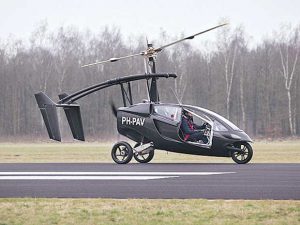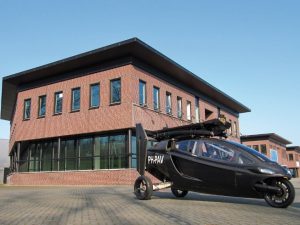[This post was co-authored with Madhulika Vishwanathan]
Flying cars. We’ve grown up with the fantasy – the Jetsons, Harry Potter, and then a flurry of sci-fi movies. We’ve all watched enthralled as Elroy and Judy Jetson travelled to school in their flying car capsule. Commuting on a daily basis via a flying car might become a reality in the near future, as PAL-V Europe NV a Dutch based company, prepares to launch a flying car in India.
As seen above, the ‘Personal Land and Air Vehicle’ (PAL-V) is a two seat, three wheeled vehicle, that can be driven to the nearest airfield for take-off, and has rotator blades that fold in when the vehicle is to be used as a car. The company plans to launch a maximum of 5 limited edition vehicles in India by 2018 that have an approximate price tag of 3.79 crores at the current Euro conversion rate. In a statement, the company confirmed that it had received interest from government institutions, hospitals, and the tourism sector in India for the model, with the Sahara Group also reportedly interested in the PAL-V.
Patent prosecution:
Pursuant to the flying car invention, PAL–V had filed a patent application In India. This application is a national phase entry of a PCT (International) application filed back in 2005, which had initially claimed a: “ Vehicle (1) for riding on land and flying in air, comprising: a cabin (2) with wheels (3; 4), the cabin (2) being designed for accommodating at least one person; a rotor (40) having a rotor axle (41), a rotor base (44) and rotor blades (45) mounted to the rotor base (44); wherein the rotor blades (45) are hingedly mounted to the rotor base (44) ; and wherein the rotor blades (45) are extendable blades.”
The examiner issued a first examination report and rejected the claims based on lack of novelty and cited three instances of prior art to support his contentions. Subsequently the applicant amended the patent claims to align with a corresponding US patent claim. However the examiner did not find the amendments persuasive and maintained the obviousness rejections. In response, the applicants further narrowed their claims to align with European granted patent. The applicants also requested a hearing and submitted arguments against the prior art rejections.
How the invention differs from prior art:
D1:DE10159082 discloses a vehicle capable of riding on land and flying on air. An important disadvantage of this known vehicle is the fact that it has fixed wings which need to be attached before flying and attached after flying. The same applies to propeller- which makes it rather cumbersome to operate.
D2:US5915649 teaches a vehicle for riding on land and flying in air. This invention differs from the present invention in that the rotor blades have a hinge at 1/3 their length diving the blades into inner section and outer section. The inner blade section is fixedly mounted to the rotor base and the outer base section is mounted with a hinge to the inner blade section.
D3:US5915649 discloses a roadable helicopter with two rotors and a rotor bay into which the rotors are stored when the helicopter is in the road condition. An important distinguishing feature is that according to D3 the rotor axle is titled with respect to the cabin – so for vertical take-off it is necessary to tilt the cabin by lowering the front wheels.
Final amended claims:
“Vehicle (1) for riding on land and flying in air, comprising: a cabin (2) with wheels (3; 4), the cabin (2) being designed for accommodating at least one person; a rotor (40) having a rotor axle (41), a rotor base (44) and rotor blades (45) mounted to the rotor base (44); wherein the rotor blades (45) are hingedly mounted to the rotor base (44) ; and wherein the rotor blades (45) are extendable blades; characterized in that each rotor blade (45) is provided with a coupling member (49) attached to rotor base (44), the rotor blade (45) being capable of shifting along said coupling member (49) in a longitudinal direction; wherein a rotor blade (45) comprises a hollow passage (51) extending to a chamber (52)and wherein said coupling member (49) comprises a support bar extending into said hollow cylindrical passage and having a piston head (53) fitting in said chamber (52); the rotor blade further being provided with hydraulics for adapting the setting of the rotor blade.”
After considering the applicant’s second amendment and arguments, the Controller determined that the invention was patentable and issued the patent. The Controller’s decision can be accessed here.
Practical considerations:
“We wanted flying cars, instead we got 140 characters.” – Recent events would appease Peter Thiel, who made this statement in his 2011 manifesto titled ‘What happened to the future?’ He complained of innovation remaining focused on social media, while more ambitious advances remained unexplored. It would now seem that innovation is indeed shifting, with autonomous, or self-driving cars increasingly becoming more commonplace than revolutionary – and flying cars just seem to be the next logical step.
However, like the autonomous car, getting past legal, regulatory and safety hurdles seem to be more difficult than perfecting the technology in flying cars will be. While former NASA engineer Mark Moor is of the opinion that it might be easier to put flying cars in the skies before autonomous cars hit the roads, perhaps due to the lack of obstacles in the sky – that logic works both ways. In 2013, an experimental flying car that was kept aloft by a parasail and a rear propeller crashed near an elementary school in Canada, which raised questions of how mechanical failures of these flying cars will be handled, and how much easier it would be to deal with a similar problem in an autonomous car. While the dream lives on, the practicality of it all needs to be reconsidered. A comment on Arstechnica’s post hits the nail on the head when it calls flying cars ‘fish out of water’ – you could probably buy a better plane for less money, a better car for less money, and probably even a better plane and a better car for less money.
Indian patent regime: A strong framework?
In the recent past, India has received lots of flak from big pharma over its patent regime especially regarding policies around Section 3(d) and compulsory licenses. Thankfully, aeronautical companies do not agree. In the past, American aircraft major Boeing has testified about their positive experience with the Indian patent regime before the US committees. In this case, however, a patent was issued to PAL-NV after they addressed the prior art contentions satisfactorily. The Indian granted patent claims are comparable to the claims in the European granted patent – which in turn, are narrower than the corresponding US claims. More often than not, it’s only patent revocations, compulsory licenses and oppositions that make news, which gives rise to the impression that the Indian patent regime does not foster innovation. Hopefully cases like these will dispel the misconception.
(Images from here, here and here).



